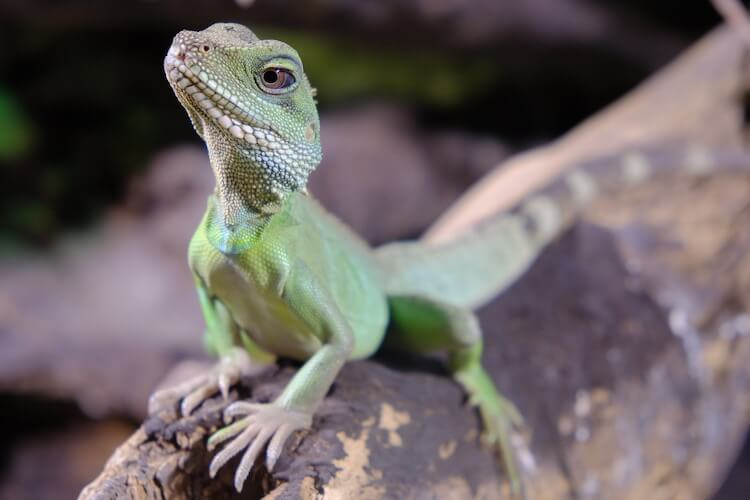Water Dragon Care Sheet
Chinese water dragons, also known as the green water dragon or Asian water dragon. They originate from the southeast Asian mainland — Thailand, southern China, Vietnam and Cambodia.
Given optimal care, green water dragons can live up to 16 years. While they occasionally fight among themselves or compete for superiority with cage mates, they are rarely aggressive toward human keepers. If frightened, they might give you an open-mouthed threat, which they rarely follow through on, or a light tail whip when picked up. If scared, they may turn dark or try to hide behind a plant or in their water.
Adult males grow to approximately 3 feet in length; adult females measure approximately 2 feet. The tail is laterally flattened, banded brown and green, ends in a fine point and makes up 70 to 75 percent of their length. Water dragons use their tails for balance and leverage when climbing, and they can use them to whip would-be attackers, predators or keepers.
Chinese Water Dragon Enclosure
Caring for Chinese water dragons is not all that difficult but their needs are very specific (as are most reptile species’). They are arboreal lizards, meaning they climb and like to be up high. An ideal enclosure for one or more adult dragons would measure 6 feet tall, 3 to 4 feet deep and 4 to 6 feet long. Water dragons enjoy a humid environment, so maintain cage humidity at close to 80 percent. Wooden vivarium is best. Green water dragons enjoy swimming and soaking in water. Provide a large pan that’s deep enough to allow soaking (hatchlings do fine a with shallow pan). Change the water frequently to maintain cleanliness.
Chinese water dragons are susceptible to Pseudomonas infections and often pick these up in water areas that have not been well maintained. Nonfiltered water areas need cleaning once a day, and filtered water areas should have a complete water change and cleaning no less than every three or four days. Maintaining cage humidity can be difficult. Enclosed cages, those built with glass or wood, with sliding doors and solid lids often easily maintain humidity at the proper levels. Open-topped glass tanks and screened cages pose more difficulty. Moving water in the cage helps increase humidity. You may use something simple, such as an air-stone bubbler placed in the water, or create an impressive waterfall using an aquarium powerhead. Live plants and substrates that hold moisture also help increase cage humidity, as does misting the cage once or twice a day with a spray bottle.
As arboreal creatures, water dragons need some high basking areas in the cage to rest in. Climbing branches or shelves within the enclosure will allow them to reach the upper limits of the cage. Live or artificial plants and leafy green foliage throughout the enclosure provide shelter and will make your water dragon feel more secure in its environment.
Substrate – coco fibre, coarse bark.
Daytime temperatures should range from 84 to 88 degrees Fahrenheit, with a basking area of 95. Night-time temperatures should range from 75 to 80 degrees. It’s a good idea to have at least two thermometers in the cage, one in the cool side and one in the warm side of the enclosure. Improper temperature ranges can lead to a water dragon with a weakened immune system and inadequate digestion of nutrients due to slower metabolism.
Chinese Water Dragon Lighting Information
You will need to provide UVB in the form of fluorescent or metal halide lighting. Your water dragon will need UVB to produce vitamin D3 in its skin, which in turn aids it in using the calcium in its diet properly. Without proper UVB lighting, water dragons often develop nutritional secondary metabolic bone disease, which causes their bones to soften, bend and break easily. It can also lead to tremors, seizures and even death if action isn’t taken to reverse the deficiency. Set UVB lighting fixtures over your dragon’s basking area. There should not be glass or plastic between the light and the dragon as this will block most of the UVB rays from reaching your lizard. The light should also sit no more than 10 to 12 inches above your dragon to provide the highest level of UVB.
Uvb 150
Incandescent basking lights can maintain proper cage temperatures, and their heat combined with misting helps maintain humidity. Water dragons are diurnal lizards, meaning they are active during the day and sleep at night. The lights, therefore, need to go off at night. For this reason, a lightless heat source, such as a ceramic heat emitter for day and night heating might also prove beneficial. Set the ceramic heat emitter on a thermostat control to maintain the needed temperature range. Your water dragon should have light during normal seasonal daylight hours. I use a timer to create a day/night cycle; it turns the lights on at 7 a.m. and turns them off near sunset, perhaps 7 p.m.
Chinese Water Dragon Food
Chinese water dragons eat a variety of live food items ranging from crickets, mealworms, locust, waxworms, earthworms, , pinkies and fuzzies. You may try to offer finely shredded vegetables and small chunks of fruit, but these items should make up only about 10 to 15 percent of your dragon’s diet if you are able to get it to eat them. Whole prey items, such as pinkies, fuzzies and feeder fish, are an important component of a juvenile-to-adult water dragon’s diet. These items are high in calcium and other nutrients, and if offered to the dragon two or three times a week will help maintain a good bone structure.
For any further information or advice please feel free to ask a staff member in store or contact the store on 01902 494860
To see other other care sheets, click here.




